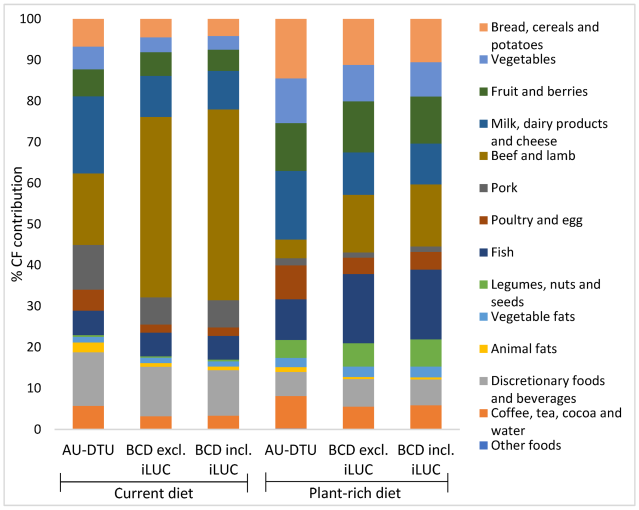Reducing the carbon footprint following the Danish Climate-Friendly Dietary Guidelines

The global food system contributes to the environmental burdens and has been assessed as unsustainable. Indeed, it has a negative impact on greenhouse gas emissions as it accounts for approximately 21% to 37% of overall global anthropogenic greenhouse gas emissions (Rosenzweig, 2020). In line with the agreement of the Danish parliament upon the aim of a reduction of 70% in GHG emissions by 2030 compared to 1990 (Danish Ministry of Climate, 2020), “the Official Danish Dietary Guidelines-good for health and climate” were launched to contribute to reach this goal by transitioning to a more plant-based and still healthy diet. A plant-rich diet is low in meat and discretionary foods, high in fruit, vegetables, legumes, nuts, seeds, wholegrain products and potatoes, and moderate in fish, dairy products, eggs and vegetable oils (Lassen, 2020).
This study aims to estimate the carbon footprint reduction related to the transition from the current Danish diet to the new “Official Dietary Guidelines – good for health and climate”, with two different databases, both using life cycle assessment :
- AU-DTU data set, based on an attributional life cycle assessment (with average literature-based data)
- BCD data set, divided in two sub-databases: one including the indirect land use change (BCD incl. iLUC) and one excluding the indirect land use change (BCD excl. iLUC). BCD data sets use a top-down hybrid approach and consequential LCA (with statistical data) (Schmidt, 2021).
Transitioning from the current Danish diet to the plant-rich diet leads to a great carbon footprint reduction
A transition to a plant-rich diet showed a great reduction of the carbon footprint at the retail gate: 31% with AU-DTU data (3.01 kg C02-eq per10 MJ), and 43% and 44% when using BCD excl. iLUC and incl. iLUC respectively (2.72 and 3.04 kg C02-eq per10 MJ). Similar reductions were also found when household losses were included in calculations (Table 1).
Retail gate level |
Household level |
|||
| GHGe calculated with AU-DTU data set (kg CO2-eq/10 MJ) | GHGe calculated with BCD data set (kg CO2-eq/10 MJ) | GHGe calculated with AU-DTU data set (kg CO2-eq/10 MJ) | GHGe calculated with BCD data set (kg CO2-eq/10 MJ) | |
| Current Danish diet | 4.37 | 4.79 – 5.46* | 4.78 | 5.29 – 6.04* |
| Climate-friendly diet | 3.01 | 2.72 – 3.04* | 3.32 | 3.02 – 3.38* |
*values indicate the inclusion (low value) or non-inclusion (high value) of indirect land use change (iLUC) effects
Table 1 : GHGe of the current Danish diet and the Climate-Friendly diet assessed at retail gate level and household level with two data sets (mean)
Animal-based products are the greatest contributors of the carbon footprint reduction
- With AU-DTU data set:
In the current Danish diet, animal products accounted for 61% of the total carbon footprint while plant-based products accounted for 21%.
In the plant-rich diet, the carbon footprint estimated for animal products was 42% and 44% for plant-based products. The carbon footprint reduction was mainly due to the lower amount of beef and lamb in the plant-rich diet, which corresponded to a decrease of 0.63 kg CO2-eq per 10 MJ (Figure 1).
- With BCD data set:
In the current diet, animal products accounted for 69% and 71%; and plant-based products accounted for 16% and 14%, excl. and incl. iLUC respectively.
In the plant-rich diet, animal products accounted for 47% and 48% and plant-based products for 41% and 40% excl. and incl. iLUC respectively. The lower amount of beef and lamb accounted for a decrease of 1.7 kg CO2-eq per 10 MJ, which is 2.6-fold the reduction from beef and lamb with AU-DTA data (Figure 1).

Transitioning to the climate-friendly Danish diet involves to increase the consumption of plant-based products, such as vegetables and legumes and would lead to a carbon footprint reduction due to a lower consumption of meat, especially beef and lamb. The different carbon footprint reductions show the importance of the databases and methodologies selected while developing dietary guidelines.
Based on : Trolle E, et al. Carbon Footprint Reduction by Transitioning to a Diet Consistent with the Danish Climate-Friendly Dietary Guidelines: A Comparison of Different Carbon Footprint Databases. Foods. 2022 Apr 13;11(8):1119.
- Transitioning to the Danish Climate-Friendly Guidelines would reduce the carbon footprint of 31% according to a database, and 43% according to another one.
- Ruminant meat contributes the most to the carbon footprint reduction.
- LCA methodology and carbon footprint databases are important to be considered while developing guidelines to promote dietary change.
